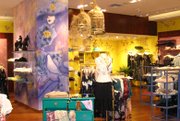Forever 21's Superstore
When Donald Chang launched his first clothing store in 1984 on Figueroa Street in Los Angeles, it was a mere 900 square feet.
But the owner and chief executive officer of Forever 21 Inc. had a dream. He envisioned that one day he would open an emporium the size of a department store.
More than 20 years later, Chang’s dream has come true. On July 15, Forever 21 opened a 40,000-square-foot store on the site of the old Saks Fifth Avenue outlet in Old Pasadena after acquiring the lease.
One block off Colorado Boulevard, it is the largest in the 400-store retail chain that the Los Angeles Business Journal called one of the fastest-growing private companies in the area.
“This is just the start of a new era for Forever 21, where we can bring our expertise to more customers,” said Larry Meyer, one of the company’s senior vice presidents and main spokesman.
The new Forever 21 store is an elegant space with marbletiled floors, Lucite chandeliers and a curving stairway that leads to the second floor. The merchandise is displayed in distinct sections with their own design and theme and is showcased under bright white lights.
“In this store, we are trying to accomplish a lot of boutiques in a big space,” said Sayuri Takeda, who does store planning and design for Forever 21. Design was done by an in-house team with consultation from J.T. Nakaoka Associates in Los Angeles.
At the store entrance, customers are greeted with an accessories section, where baubles, bangles, sunglasses, purses and belts stand out among the candelabras that dot the area. Womenswear is interspersed throughout the store among other areas dedicated to lingerie, menswear and childrenswear. Forever 21 added men’s and childrenswear to its stores last May.
Upstairs, a vintage theme for antique-looking clothing is accented with colorful wallpaper and distressed hardwood floors. Another section, which has a pink ceiling and pink walls, houses T-shirts, shorts and cotton dresses.
Company executives shopped in vintage furniture stores all around Southern California to come up with distressedlooking display tables, burlwood chairs and other antiques located throughout the store.
The idea was to keep everything looking spacious but feeling comfortable.
“We have always been constrained by space,” Meyer said. “Our stores that are 6,000 square feet have long lines to the dressing rooms.” (In the Pasadena store, 22 dressing rooms—whose doors have frosted portholes—line both sides of a wide hall.)
Forever 21 is a company that never seems to stand still. Last year, revenues totaled $925 million. This year, they are expected to hit $1.1 billion, Meyer said, noting that the company grows by about $200 million a year.
“They have done a good job of seeing what the market wants and quickly providing it,” said Jeff Mintz, a retail research analyst in Los Angeles with Wedbush Morgan Securities.
Other analysts agree. “These guys have done an amazing, amazing job,” said Jeffrey Van Sinderen, a senior analyst with B. Riley & Co. in Los Angeles. “They have been doing fast-fashion and offering a very broad assortment of merchandise, one of the broadest out there.”
Heading to the mall
Forever 21 opened its first mall-based store in Panorama City, Calif., in 1989, and has been a mall staple every since. The company is known for its quick-turning merchandise (or fast-fashion), as well as reasonable price points, where cotton dresses sell for $28.80, tops for under $20 and faux leather purses for $27.80. More than 50 percent of Forever 21’s merchandise is manufactured in Los Angeles.
Its retail clients tend to be fairly young. About 20 percent of its customers are over 18 years old; 45 percent fall into the 18- to 24-year-old range; and 35 percent are over 24 years old.
Forever 21 has always been big on generating new ideas. In 2001, the company opened Forever XXI, a larger store that averages 24,000 square feet. And in 2005, it launched a new concept called For Love 21—smaller boutiques that range from 1,800 to 3,000 square feet and sell only accessories. Currently, there are 10 accessory stores. Five more will be added by year’s end.
And earlier this month, Forever 21 purchased 44 Rampage stores owned by San Diego–based Charlotte Russe Inc. for $14 million. The idea is to convert about 25 of these stores to the Forever 21 nameplate and then launch a new concept store with the rest, Meyer said.
“The new concept stores will have aspects of this store [the Pasadena store] with men’s and womenswear,” he said. These stores, which could debut as early as October, will have a new still-tobe determined name, appeal to a customer who is 28 years old and above, and have merchandise that is slightly more sophisticated and urban, Meyer explained.
But the merchandising scheme will always be the same—fast-fashion where goods move on a weekly basis. “The key to retail is keeping it fast,” he said. “Otherwise things get boring.”
And if Forever 21 can find the right retail space, the company could be adding more department stores to its every-changing retail lineup.






















